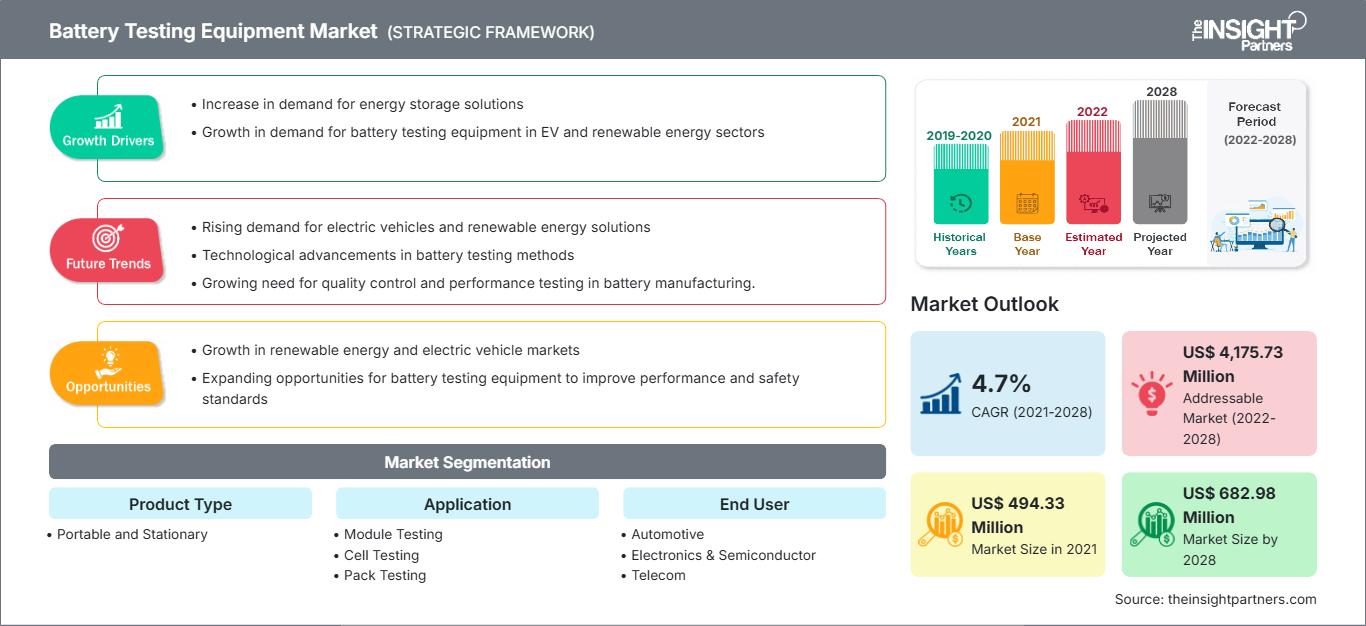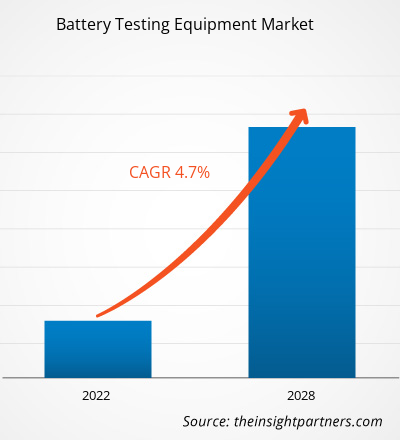Il mercato delle apparecchiature per il test delle batterie è stato valutato a 494,33 milioni di dollari nel 2021 e si prevede che raggiungerà i 682,98 milioni di dollari entro il 2028; si stima una crescita a un CAGR del 4,7% dal 2021 al 2028.
Settori come l'aerospaziale e la difesa, l'automotive e la sanità stanno investendo massicciamente in tecnologie avanzate per rafforzare le proprie capacità con macchinari all'avanguardia e offrire servizi migliori ai clienti. Aziende negli Stati Uniti, in Francia, in Svezia, nel Regno Unito e in altri paesi stanno sviluppando apparecchiature avanzate per il test delle batterie per i loro clienti globali. Anche il crescente approvvigionamento di batterie avanzate da parte dell'esercito statunitense sta sostenendo la crescita del mercato. Inoltre, si prevede che lo sviluppo di eVTOL e le iniziative intraprese da governi di paesi come Germania, Emirati Arabi Uniti e Singapore per lo sviluppo di infrastrutture per la mobilità aerea urbana in questi paesi stimoleranno la crescita del mercato delle apparecchiature per il test delle batterie.
L'aumento della spesa per la difesa in paesi come Stati Uniti, Cina e India, e altri, dovrebbe trainare la crescita del mercato delle apparecchiature per il test delle batterie nei prossimi anni. I paesi in via di sviluppo, come India, Cina e Indonesia, si concentrano sul rafforzamento delle proprie capacità militari a causa dei crescenti scontri lungo i confini con i paesi confinanti. L'espansione dei settori manifatturieri in paesi come Cina e India sta ulteriormente stimolando la crescita del mercato delle apparecchiature per il test delle batterie.
Personalizza questo rapporto in base alle tue esigenze
Potrai personalizzare gratuitamente qualsiasi rapporto, comprese parti di questo rapporto, o analisi a livello di paese, pacchetto dati Excel, oltre a usufruire di grandi offerte e sconti per start-up e università
Mercato delle apparecchiature per il test delle batterie: Approfondimenti strategici

-
Ottieni le principali tendenze chiave del mercato di questo rapporto.Questo campione GRATUITO includerà l'analisi dei dati, che vanno dalle tendenze di mercato alle stime e alle previsioni.
Impatto della pandemia di COVID-19 sulla crescita del mercato nordamericano delle apparecchiature per il test delle batterie
Gli Stati Uniti sono il paese più colpito del Nord America a causa del COVID-19. Molti stabilimenti produttivi sono stati temporaneamente chiusi o operano con personale ridotto al minimo; la catena di fornitura di componenti e parti è interrotta; queste sono alcune delle criticità affrontate dai produttori nordamericani.
Poiché gli Stati Uniti dispongono di un numero maggiore di apparecchiature per il test delle batterie, produttori di componenti e industrie, l'epidemia ha gravemente influenzato la produzione e la generazione di fatturato. Il minor numero di personale di produzione ha comportato una minore quantità di produzione. D'altro canto, la limitata disponibilità di materie prime e la chiusura del settore aerospaziale hanno avuto un impatto anche sul mercato statunitense delle apparecchiature per il test delle batterie. Tuttavia, si prevede che la crescente spesa militare del paese e il crescente sviluppo di veicoli elettrici da parte di aziende come Tesla offriranno opportunità di crescita agli operatori del mercato delle apparecchiature per il test delle batterie nel prossimo futuro.
Approfondimenti di mercato - Mercato delle apparecchiature per il test delle batterie
La crescente domanda di trasporti guiderà il
A causa dell'aumento del reddito disponibile delle persone nelle economie in via di sviluppo, come Cina, India, Corea del Sud e altre, la domanda di veicoli è aumentata. Secondo la Society of Indian Automobile Manufacturers (SIAM), le vendite di veicoli per passeggeri in India sono aumentate del 26,45% da settembre 2019 a settembre 2020. Si prevede che fattori come l'aumento degli investimenti da parte di importanti aziende produttrici di veicoli e le norme governative favorevoli in materia di produzione di veicoli in tutta l'Asia-Pacifico guideranno la crescita del mercato delle apparecchiature per il test delle batterie nella regione. Inoltre, si prevede che le iniziative intraprese dai governi di paesi come il Vietnam per espandere la propria industria automobilistica stimoleranno le dimensioni del mercato delle apparecchiature per il test delle batterie.
Approfondimenti basati sulla tipologia di prodotto
In base alla tipologia di prodotto, il mercato delle apparecchiature per il test delle batterie è segmentato in apparecchiature per il test delle batterie portatili e apparecchiature per il test delle batterie fisse. Il segmento delle apparecchiature di test per batterie stazionarie ha guidato il mercato delle apparecchiature di test per batterie, con una quota di mercato del 54,1% nel 2020. Il test per batterie stazionarie viene eseguito per un test di capacità quando la batteria è nuova, come parte del test di accettazione, per il test di impedenza per stabilire i valori di base della batteria e per ripetere il processo di test sopra descritto entro 2 anni per la garanzia della batteria. Il processo di test controlla l'impedenza trimestralmente sulle celle al piombo-acido regolate da valvola (VRLA) ed esegue test di capacità ogni 25% della durata di servizio prevista.
Approfondimenti basati sulle applicazioni
In base all'applicazione, il mercato delle apparecchiature di test per batterie è segmentato in test di moduli, test di celle e test di pacchi. Il segmento dei test di celle ha guidato il mercato nel 2020. I test di stress delle celle vengono eseguiti per valutare la risposta a sollecitazioni elettriche, ambientali e meccaniche, tra le altre. Il test di celle garantisce una lunga durata della batteria e simula complessi profili di test reali. Inoltre, i tester per celle sono progettati per eseguire test su batterie agli ioni di litio, condensatori elettrici a doppio strato (EDLC) e condensatori agli ioni di litio (LIC). Si prevede che ciò aumenterà le dimensioni del mercato delle apparecchiature di test per batterie.
In base all'area geografica, il mercato delle apparecchiature di test per batterie è segmentato in cinque regioni principali: Nord America, Europa, APAC, MEA e SAM. Nel 2020, il Nord America ha detenuto la quota di fatturato maggiore, seguito rispettivamente da Europa e APAC. Si prevede che il mercato nell'APAC crescerà al CAGR più rapido, pari al 5,8%, dal 2020 al 2028. Arbin Instruments, Century Yuasa Batteries Pty Ltd., Chauvin Arnoux, Chroma Systems Solutions, Inc., DV Power, Extech Instruments, Megger, Midtronics, Inc., Storage Battery Systems, LLC e Xiamen Tmax Battery Equipments Limited sono tra i principali attori dell'ecosistema analizzati durante questo studio di mercato.
Approfondimenti regionali sul mercato delle apparecchiature per il collaudo delle batterie
Le tendenze regionali e i fattori che influenzano il mercato delle apparecchiature per il test delle batterie durante il periodo di previsione sono stati ampiamente spiegati dagli analisti di The Insight Partners. Questa sezione illustra anche i segmenti e la geografia del mercato delle apparecchiature per il test delle batterie in Nord America, Europa, Asia-Pacifico, Medio Oriente e Africa, America Meridionale e Centrale.
Ambito del rapporto di mercato sulle apparecchiature di prova delle batterie
| Attributo del rapporto | Dettagli |
|---|---|
| Dimensioni del mercato in 2021 | US$ 494.33 Million |
| Dimensioni del mercato per 2028 | US$ 682.98 Million |
| CAGR globale (2021 - 2028) | 4.7% |
| Dati storici | 2019-2020 |
| Periodo di previsione | 2022-2028 |
| Segmenti coperti |
By Tipo di prodotto
|
| Regioni e paesi coperti |
Nord America
|
| Leader di mercato e profili aziendali chiave |
|
Densità degli operatori del mercato delle apparecchiature per il collaudo delle batterie: comprendere il suo impatto sulle dinamiche aziendali
Il mercato delle apparecchiature per il test delle batterie è in rapida crescita, trainato dalla crescente domanda degli utenti finali, dovuta a fattori quali l'evoluzione delle preferenze dei consumatori, i progressi tecnologici e una maggiore consapevolezza dei vantaggi del prodotto. Con l'aumento della domanda, le aziende stanno ampliando la propria offerta, innovando per soddisfare le esigenze dei consumatori e sfruttando le tendenze emergenti, alimentando ulteriormente la crescita del mercato.

- Ottieni il Mercato delle apparecchiature per il test delle batterie Panoramica dei principali attori chiave
Gli operatori che operano nel mercato delle apparecchiature di test per batterie si concentrano principalmente sullo sviluppo di prodotti e collaborazioni avanzati ed efficienti.
- Nel 2021, Keysight Technologies, Inc. e Proventia Oy hanno collaborato per migliorare le soluzioni di test per le batterie dei veicoli elettrici (EV).
- Nel 2021, Chroma ha lanciato un sistema di test per la ricarica rapida degli scooter elettrici per aiutare l'associazione CHAdeMO a verificare gli stimolatori dell'interfaccia di ricarica dei veicoli elettrici. In linea con la crescita internazionale del settore dei veicoli elettrici, contribuirà anche a definire il Protocol Check Sheet per gli standard di test per la ricarica rapida dei veicoli elettrici a due ruote.
- Analisi storica (2 anni), anno base, previsione (7 anni) con CAGR
- Analisi PEST e SWOT
- Valore/volume delle dimensioni del mercato - Globale, Regionale, Nazionale
- Industria e panorama competitivo
- Set di dati Excel
Report recenti
Rapporti correlati
Testimonianze
Motivo dell'acquisto
- Processo decisionale informato
- Comprensione delle dinamiche di mercato
- Analisi competitiva
- Analisi dei clienti
- Previsioni di mercato
- Mitigazione del rischio
- Pianificazione strategica
- Giustificazione degli investimenti
- Identificazione dei mercati emergenti
- Miglioramento delle strategie di marketing
- Aumento dell'efficienza operativa
- Allineamento alle tendenze normative






















 Ottieni un campione gratuito per - Mercato delle apparecchiature per il test delle batterie
Ottieni un campione gratuito per - Mercato delle apparecchiature per il test delle batterie